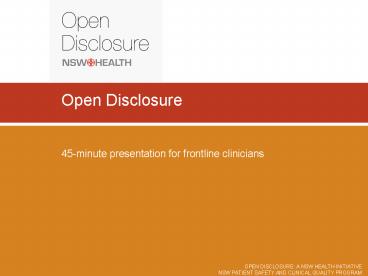Open Disclosure PowerPoint PPT Presentation
1 / 17
Title: Open Disclosure
1
Open Disclosure
- 45-minute presentation for frontline clinicians
2
What is Open Disclosure?
Open Disclosure is a frank discussion with a
patient and/or their support person(s) about an
incident that resulted in harm or injury to the
patient. NSW Open Disclosure Policy Directive
PD2007_040
3
Why is Open Disclosure important?
- Patients value honesty, empathy and transparency.
- Its the right thing to do.
- Staff are supported by NSW Health and the NSW
Government to always practise Open Disclosure. - Nurtures an open and just culture that values
learning from incidents.
4
Principles of Open Disclosure
4
- Openness and timeliness of communication.
- Acknowledgement of incident.
- Expression of regret.
- Recognition of the patients reasonable
expectations regarding their care. - Support for health staff.
- Confidentiality.
5
General and High Level Open Disclosure
- An incident is any unplanned event resulting in,
or with the potential for, injury, damage or
other loss. - General level refers to SAC 3 or SAC 4 incidents
and involves frontline clinicians, such as
nurses, residents, JMOs, allied health
professionals. - High level refers to SAC 1 and SAC 2 incidents
and involves senior clinicians and management and
is a more detailed process.
6
Steps of Open Disclosure
- Acknowledge the incident and its impact.
- Explain the known clinical facts.
- Apologise for what has occurred.
- Reassure and agree on a plan for ongoing care
- Investigate the incident to learn what has
happened. Remember that staff and patients have a
different understanding of whats involved in an
investigation. - Feedback to patient and staff.
- Document by notifying in IIMS and the patients
medical record.
7
An easy way to remember the steps is
Explain Apologise Reassure
8
Your role and responsibility
- To support and practise Open Disclosure.
- To support your colleagues in practising Open
Disclosure. - To focus on the patients needs and expectations
if an incident occurs. - To initiate the Open Disclosure process within 24
hours of the incident or when it was identified.
9
Key factors in apologising
When apologising, remember
- Timeliness
- Empathy
- Legal considerations
- Open Disclosure is not about assigning blame.
Dont blame - yourself
- another staff member
- an organisation
- the patient
10
Examples of what and what not to say
- You could say
- ? Mrs Smith, unfortunately we took an x-ray of
your left hand rather than than your right hand.
Im really sorry this happened, but we would like
to do another x-ray now if thats OK. We will be
reviewing our procedures to find out why this
occurred and to ensure it wont happen again. - ? I am very sorry this has happened.
- What NOT to say
- ? We x-rayed the wrong side. Sorry, but weve
been really busy today and these things happen.
Well do you again now. "
11
Putting it into practice a case study
12
(No Transcript)
13
Legal considerations
- Section 68 of the Civil Liability Act 2002 states
that an apology does not constitute an express
or implied admission of fault or liability and is
not admissible in any civil proceedings as
evidence of fault or liability. - An apology is not an admission of liability if it
is given in accordance with the NSW Health Open
Disclosure Guidelines
14
Open Disclosure requires
- supportive environment
- strong commitment
- strong leadership
- strong support from
- Clinical Excellence Commission
- Australian Medical Association (NSW)
- Medical Defence Organisations (MDOs)
- Treasury Managed Fund (TMF)
- Professional Colleges Associations
15
Who to go to for support
- The Director of Clinical Governance in each AHS
has overall responsibility for Open Disclosure. - Staff can seek support from
- Clinical Governance Unit
- Line managers, senior clinicians and clinical
teams - Employee Assistance Program
- Medical Defence Organisations
- Patient Safety Officers
- Open Disclosure mentors and support network
- Patients can seek support from
- Patient Liaison Officers
16
Resources
Open Disclosure websitehttp//www.health.nsw.gov.
au/quality/opendisc/index.html Open Disclosure
Guidelineshttp//www.health.nsw.gov.au/policies/g
l/2007/GL2007_007.html Open Disclosure Policy
Directivehttp//www.health.nsw.gov.au/policies/pd
/2007/PD2007_040.html
17
Questions?

